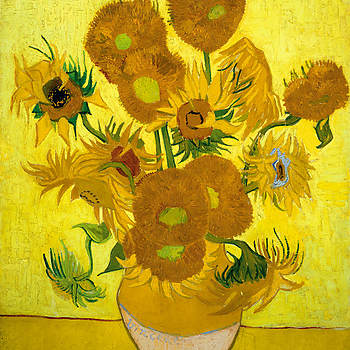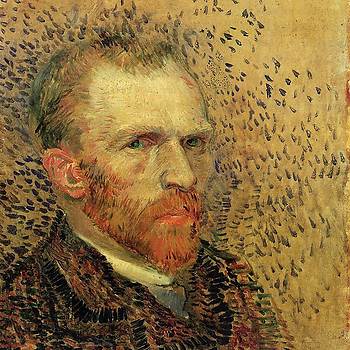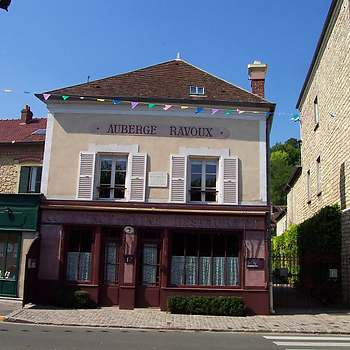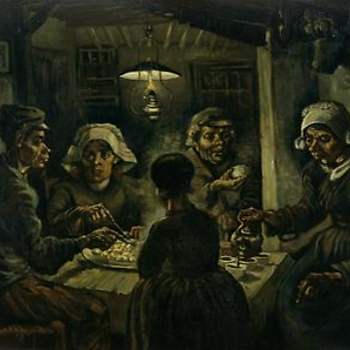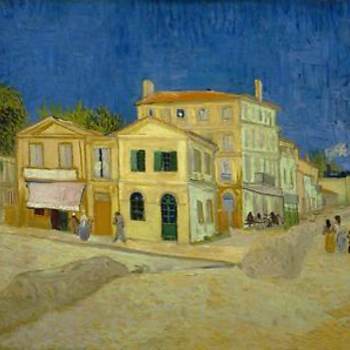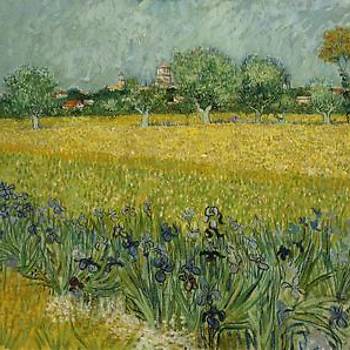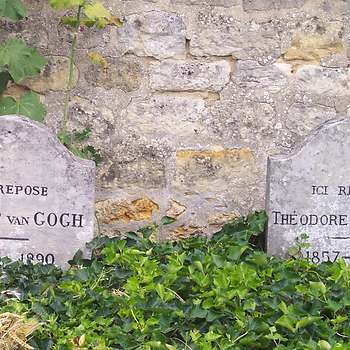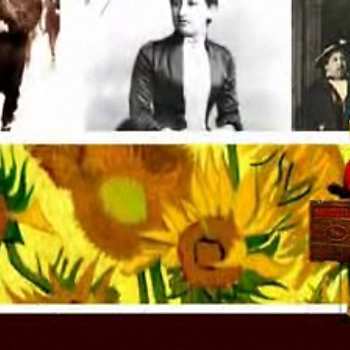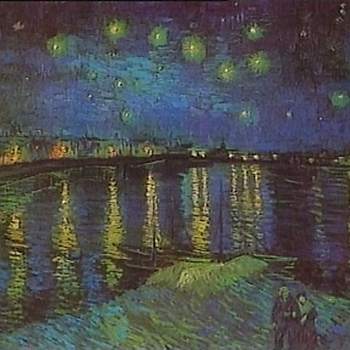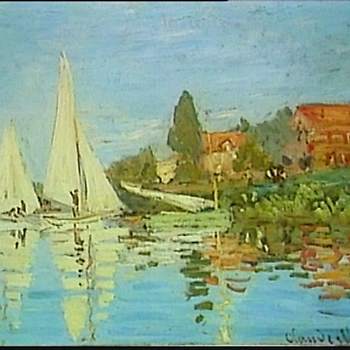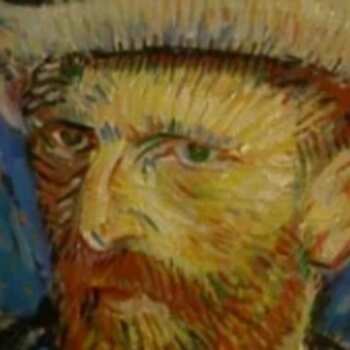Artist
Vincent van Gogh is born in 1853 in the village of Zundert, in the province of Brabant. At a young age, he already travels extensively across the Netherlands and Europe. After countless jobs and a failed attempt at university study, Van Gogh eventually opts for an existence as an artist. He takes painting lessons and draws a lot. In 1885, he paints his famous The Potato Eaters in Nuenen: a gloomy and dark portrait of a peasant family. This painting style and its theme – the life and suffering of ordinary people – are characteristic of Van Gogh’s early work.
The following year, he moves to Paris, the city in which many people are engaged in the innovation of painting. His brother Theo is an art dealer here; he introduces Vincent to the paintings and drawings of the French Impressionists. These painters’ use of light and colour is more refined than what Van Gogh is accustomed to. It inspires him to experiment: his work becomes more colourful and he starts to paint with the short brush strokes that will later become world famous. He also collects Japanese woodcuts, whose influence is reflected in his later work.
In 1888, Van Gogh rents a studio in the south of France: the “Yellow House” in Arles, made famous by his rendition of it. To his sister Wil he writes that the lavish natural beauty of the south calls for a new way of painting. “Distinctly colourful: sky blue, pink, orange, vermillion, bright yellow, bright green, bright wine red, violet”. He often paints landscapes and because he cannot afford a model, he paints many self-portraits.
Illness and death
Vincent van Gogh’s life is marked by upheaval, lost loves, and financial problems. He frequently quarrels with his artist friends. One day, a conflict gets out of hand and Vincent threatens fellow artist Paul Gauguin with a razor. Shortly afterwards, Van Gogh cuts off a piece of his own left ear, either accidentally or on purpose. Some of his self-portraits show him with a bandaged ear. Van Gogh is increasingly troubled by mental problems. For a while, he has himself committed to a psychiatric institution, in which he produces renowned paintings of cypresses and starry skies. On 27 July 1890, he walks into a corn field and shoots himself in the chest. He dies two days later.
World fame
His fame does not begin to grow until after his death. On the one hand, this can be attributed to his paintings, which are powerful, colourful, and unique. On the other hand, the story of his life excites wide interest: he is the textbook example of an artist who is as brilliant as he is lonely. Moreover, his work inspires many later painters.
Nowadays, Vincent van Gogh is world famous. Every year, the Van Gogh Museum in Amsterdam attracts some two million visitors, more than 80 per cent of whom come from abroad. His work is also on display in other museums, both within and beyond the Netherlands. The artist Vincent van Gogh is currently held in such great esteem that his work is worth a lot of money. In 2017, Christie’s auctions his Laboureur dans un champ for nearly 70 million euros.
Vincent van Gogh
Painter in a new age
The story of his life is as colourful as many of his paintings. In his lifetime, his radically innovative painting style is appreciated by virtually no-one. As a result, he feels lonely and unrecognised. Only after his suicide does he rise to fame; nowadays, his paintings are admired by millions of people from all over the world.
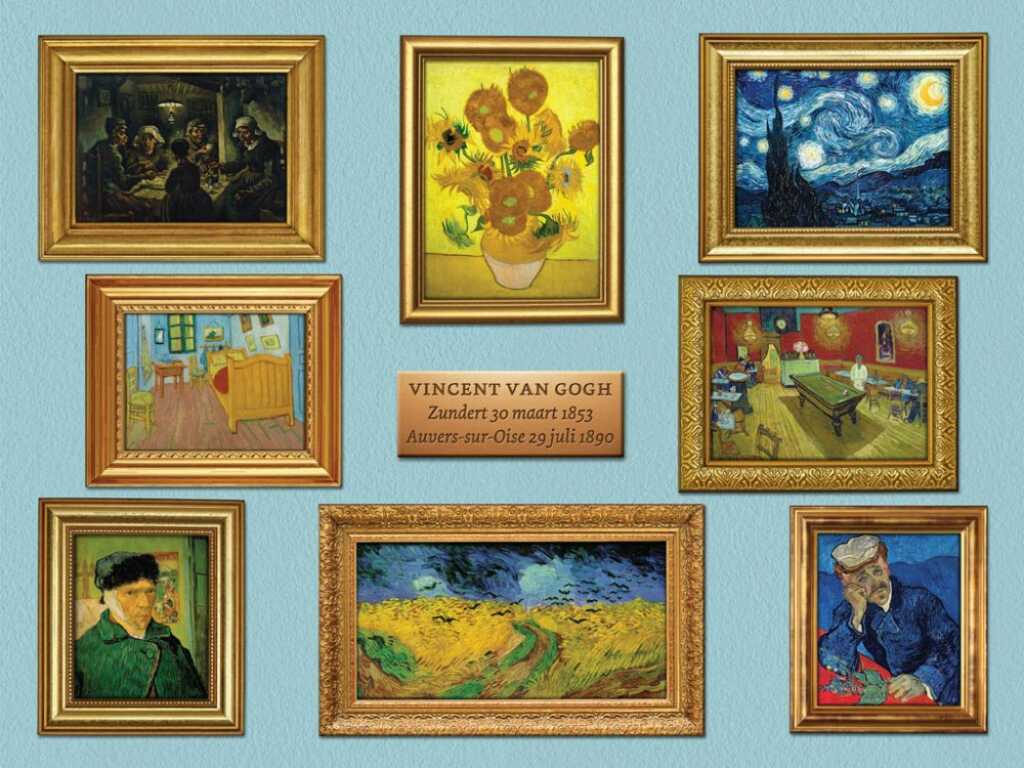
-
Vincent van Gogh
Kunstschilder Vincent van Gogh leefde in de negentiende eeuw. Dat was de tijd dat er bijvoorbeeld voor het eerst treinen, fabrieken en fototoestellen kwamen. Van Goghs schilderijen zijn tegenwoordig beroemd, maar in zijn eigen tijd wilde bijna niemand ze kopen. Hij heeft maar drie schilderijen verkocht in zijn hele leven!
-
De Aardappeleters
Dit is een schilderij dat Van Gogh maakte toen hij nog jong was. Het heet 'De Aardappeleters'. Het is een erg donker schilderij. Van Gogh wilde met 'De Aardappeleters' laten zien dat hij goed kon schilderen. De mensen op het schilderij hebben geen normale kleur. Hun huidskleur lijkt op ongeschilde aardappels!
In het begin schilderde Van Gogh altijd met donkere kleuren. Sommige mensen denken dat Van Gogh in het begin donkere schilderijen maakte, omdat hij ongelukkig was. Maar misschien vond hij dat wel gewoon mooi. De mensen uit zijn tijd vonden zijn donkere schilderijen niet mooi. Zij wilden liever schilderijen met met mensen en landschappen die net echt leken.
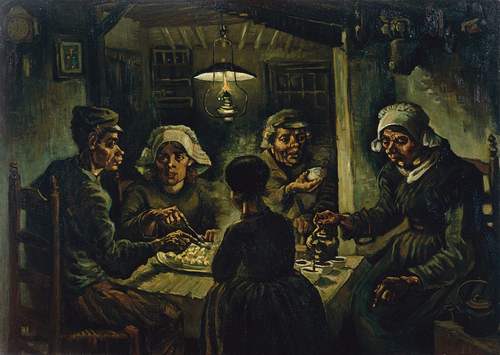
-
Zonnebloemen
Dit beroemde schilderij heet 'Zonnebloemen'. Vincent van Gogh maakte vier van deze schilderijen met zonnebloemen. Maar hij vond er maar twee echt goed gelukt. Van deze twee schilderijen maakte hij drie kopieën. (Een kopie is iets wat precies is nagemaakt.) Dit schilderij is er daar een van. Je kunt hem zelf gaan bekijken in het Van Gogh Museum.
Zie je hoe licht en kleurrijk het schilderij 'Zonnebloemen' is? Vincent van Gogh woonde twee jaar lang in Parijs. Daar zag hij de schilderijen van moderne schilders: Impressionisten. Zij wilden de indruk (ook wel impressie genoemd) die een ding op hen maakte, vastleggen. Het schilderij hoefde niet op de werkelijkheid te lijken. Het moest alleen goed een sfeer weergeven. Vaak hebben zulke schilderen hele aparte kleuren. Want met kleur kun je goed een gevoel laten zien.
Vincent vond dat mooi en ging ook zulke kleurige schilderijen maken. In plaats van donkere schilderijen, maakte hij nu schilderijen met veel kleur. Maar ook de kleurige schilderijen vonden de mensen in Van Goghs tijd niet mooi. Vincent verkocht bijna niks.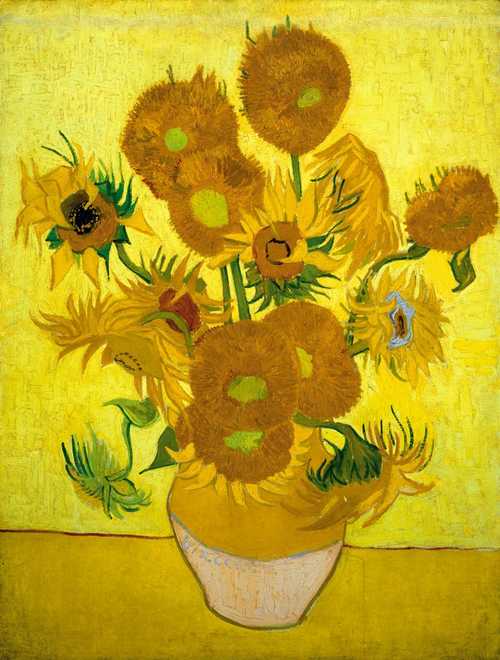
-
Sterrennacht
Zie je hoe dit schilderij van Vincent van Gogh gemaakt is? Het zijn geen ingekleurde vlakken, maar allemaal kleine streepjes naast elkaar. Vincent schilderde veel van zijn kleurige schilderijen op deze manier.
Van veraf lijkt zo'n schilderij met allemaal streepjes een gewoon schilderij. Het lijkt alsof de vlakken gewoon ingekleurd zijn. Maar als je er van dichtbij naar kijkt, zie je het wit er tussendoor. Door het wit en de streepjes lijkt het schilderij heel licht en helder.
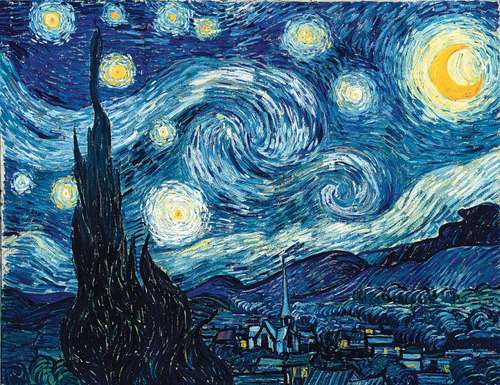
-
Zelfportret
Op dit zelfportret heeft Vincent één oor in het verband. Er zijn allerlei spannende verhalen over het oor van Van Gogh. Het bekendste verhaal is dat Van Gogh ruzie had met een vriend. Van Gogh zou zó boos zijn, dat hij zijn eigen oor had afgesneden. Volgens een ander verhaal heeft Vincents vriend het oor afgehakt. Wat er precies gebeurd is, weet niemand.
Vincent van Gogh heeft veel zelfportretten geschilderd. Hij wilde graag oefenen met schilderen, maar had geen geld om mensen te betalen die model kwamen zitten. Daarom kocht hij een goede spiegel en schilderde hij zichzelf.
De zelfportretten zijn bedoeld als oefening. Dat kun je vaak ook goed zien: ze zijn klein en ze zijn geschilderd op karton, niet op echt schilderdoek. Van Gogh maakte graag portretten. In zijn tijd werden ook de eerste foto's gemaakt. Maar dat vond Van Gogh maar niks. Een foto kan niet laten zien hoe iemand echt is, zei hij. Een geschilderd portret kan dat wel.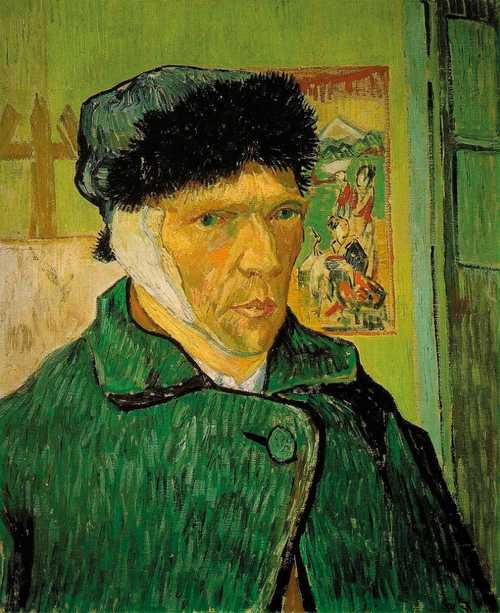
-
Van Gogh's kleuren
Boven dit café woonde Vincent toen hij in Parijs was. Het huis heet het 'Gele Huis' en het schilderij heet 'Het Nachtcafé'. Van Gogh heeft hele aparte kleuren gebruikt voor dit schilderij. Alles is geel, rood of groen. Dat deed hij niet zomaar.
Het Nachtcafé is geen vrolijk café. De mensen liggen te slapen en de meneer bij de biljarttafel heeft niemand om mee te biljarten. Van Gogh schreef aan zijn broer Theo waarom hij het café zo heeft geschilderd. Hij zegt: "Ik wilde laten zien dat het café een plek is waar je gek kunt worden. Met het geel en groen wilde ik de nare sfeer in de kroeg uitdrukken."
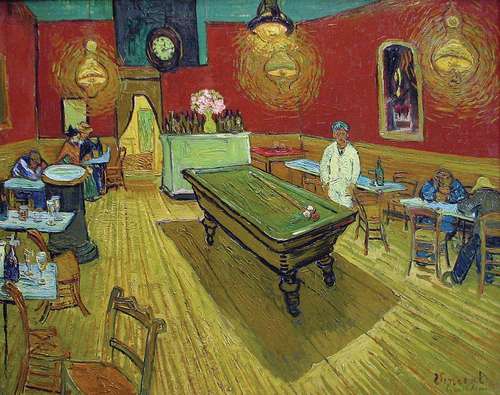
-
Van Gogh's brieven
Deze tekening deed Vincent bij een brief aan zijn broer Theo. Het is Vincent's slaapkamer in Parijs. Vincent stuurde veel brieven aan Theo. Hij vertelde daarin hoe het met hem ging. En hij liet zijn nieuwe schilder-ideeën zien. In veel brieven staan tekeningetjes, soms zelfs in kleur!
Veel van de brieven die Vincent aan Theo schreef, zijn bewaard gebleven. Zo kunnen we nu nog steeds lezen hoe Van Gogh over zijn eigen schilderijen dacht!
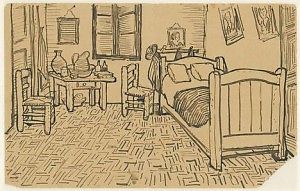
-
De dood van Vincent van Gogh
Hier zie je de graven van Vincent en zijn broer Theo. Ze liggen naast elkaar begraven, omdat ze zo'n speciale band met elkaar hadden. De graven liggen in Frankrijk, daar zijn de broers gestorven.
Vincent van Gogh verhuisde aan het einde van zijn leven naar het stadje Arles, in het zuiden van Frankrijk. Daar schildert hij het schilderij van het Korenveld. Vincent was arm en daardoor vaak somber. Hij hoopte dat het warme weer in Frankrijk hem vrolijker zou maken. Maar dat was niet zo. Vincent raakte steeds meer in de war. Het werd zelfs zo erg, dat hij in een ziekenhuis terecht kwam. Ook in de inrichting bleef hij schilderen. Soms was hij zo ziek, dat hij niet naar buiten kon. Dan tekende hij schilderijen van zijn favoriete schilders na, Rembrandt bijvoorbeeld.
Na een jaar mocht Vincent uit het ziekenhuis. Het ging eventjes goed met hem. Toch bleef hij bang om weer zijn verstand te verliezen. In de zomer van 1890 ging het fout. Vincent ging met zijn schildersspullen naar een korenveld. Daar schoot hij zichzelf neer. Hij leefde nog, maar twee dagen later stierf hij. Zijn broer Theo was bij zijn begrafenis. Een jaar later stierf Theo ook. Theo's vrouw begroef hem naast zijn broer Vincent.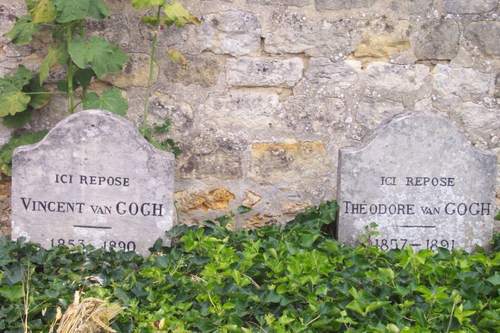
-
Vincent van Gogh nu
Weet je hoeveel geld dit schilderij kost? 82,5 miljoen dollar! Daar kun je twee grote passagiersvliegtuigen voor kopen. Tegenwoordig zijn alle schilderijen van Van Gogh heel duur. Maar in de tijd van Van Gogh was dat wel anders!
Vincent van Gogh heeft in totaal meer dan 860 schilderijen gemaakt. Met al die schilderijen heeft hij maar 288 gulden verdiend, dat is ongeveer 130 euro. Hij heeft maar drie schilderijen verkocht. Van Gogh heeft ook nog 1200 andere dingen gemaakt, bijvoorbeeld tekeningen met pen en papier.
Voor al die schilderijen en tekeningen willen mensen tegenwoordig veel geld betalen. In 1973 is er zelfs een speciaal museum voor het werk van Van Gogh geopend: het Van Gogh Museum in Amsterdam. Daar hangen de meeste schilderijen van Van Gogh. Je kunt ze daar zelf gaan bekijken! Er hangen ook schilderijen van Van Gogh helemaal in Amerika en Japan.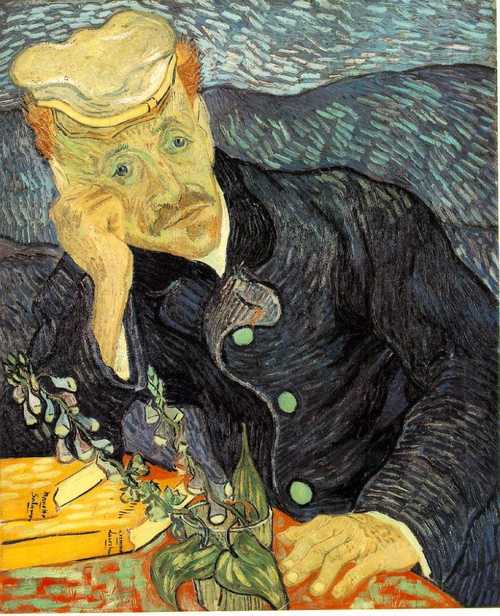
Vensterplaat Vincent van Gogh. Voor docenten: Vensterles groep 5-8. Illustratie: Kok Korpershoek.
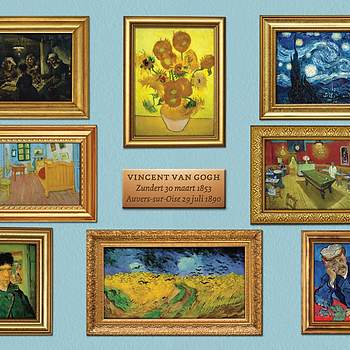
Window Image

